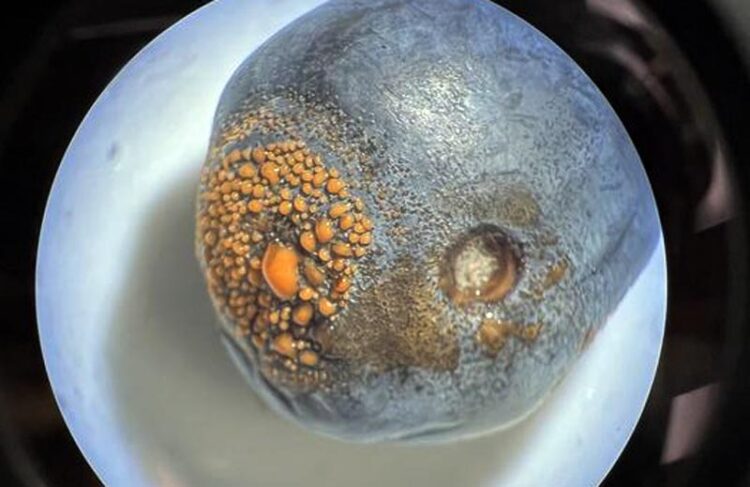Fungus versus flies: Following a scent towards insecticide-free pest management

Blueberries infected with the fungal pathogen Colletotrichum fioriniae.
Image courtesy of USDA Agricultural Research Service
Whilst a blueberry with a fungal infection might end up in most people’s compost bin, for a team of researchers in the US, it has provided a key to tackling the unsustainable use of insecticides.
In a new study published in the SCI journal Pest Management Science, the team explored how blueberries infected with a specific fungus, Colletotrichum fioriniae, emit odours which repel spotted-wing drosophila – a fruit fly that is a destructive pest of berries and cherries. By recreating the repellent aroma from the fungus, they were able to trick the flies into perceiving healthy fruit as infected.
The result? An alternative pest control method which can manipulate insect behaviour and reduce insecticide use – with no fungal infection required.
Spotted-wing drosophila (Drosophila suzukii) is a notorious pest that poses a significant threat to thin-skinned fruits, causing substantial economic losses to growers worldwide.
‘D. suzukii are very difficult to control because most of their life cycle occurs inside of fruit where they are protected from chemical sprays, leaving only the flying adult insects as potential targets for insecticides,’ explained Caitlin Rering from the United States Department of Agriculture, and one of the lead authors on the study.
‘The flies are also capable of exponential growth once infestation begins. A single female D. suzukii can produce over 350 eggs in her lifetime, and each egg can develop into an adult in as little as 10 days.’
This prolific growth means farmers currently rely on aggressive pesticide use for crop protection, leading to contamination of the environment and the promotion of insecticide resistance. The work of Rering and the team therefore contributes to the urgent need for alternative approaches to manage D. suzukii.
C. fioriniae is a threat to crops in its own right. The fungus can cause rot disease and as Rering notes, “it is certainly not an organism that farmers would want to introduce to their field”. However, by analysing the difference in odours emitted by healthy and rotting fruit, the researchers were able to identify specific volatile chemicals produced by the fungus which repel D. suzukii.
‘Of all the chemicals we tested, two seem particularly potent in repelling flies: ethyl crotonate and ethyl butyrate. These are small, simple chemicals with highly similar chemical structures. In our laboratory tests, both volatiles repelled D. suzukii from foraging and laying eggs on treated fruit.’
Rering noted that the control method exploits D. suzukii’s exquisite sensitivity to the aroma from infected fruits. ‘To a human, the fruit in the early stages of infection that we studied look and smell completely normal. However, the flies can easily distinguish between infected and uninfected fruit, even when we can’t.’
The two repellents reported in the study have significant potential for application in the field, providing growers with non-toxic alternatives to traditional chemical control methods. In particular, Rering explained how the volatiles identified could be incorporated into a pest control strategy known as “push-pull” management. The natural repellent would ‘push’ the insects away from the crop whilst an attractant would lure them towards a trap containing insecticide, killing the flies without spraying toxic chemicals over a vast area of crops.
‘Our next steps are to begin testing the repellents in the field alone and in combination with attractants in a push-pull scenario. We started testing in the field this summer and have some very promising results so far. We also want to test if these repellents will work in other fruits infested by D. suzukii, like strawberries, cherries, and raspberries.’
Journal: Pest Management Science
DOI: 10.1002/ps.7692
Article Title: Blueberries infected with the fungal pathogen Colletotrichum fioriniae release odors that repel Drosophila suzukii
COI Statement: The authors declare that they have no conflict of interest.
All latest news from the category: Agricultural and Forestry Science
Newest articles
Faster, more energy-efficient way to manufacture an industrially important chemical
Zirconium combined with silicon nitride enhances the conversion of propane — present in natural gas — needed to create in-demand plastic, polypropylene. Polypropylene is a common type of plastic found…

Energy planning in Ghana as a role model for the world
Improving the resilience of energy systems in the Global South. What criteria should we use to better plan for resilient energy systems? How do socio-economic, technical and climate change related…

Artificial blood vessels could improve heart bypass outcomes
Artificial blood vessels could improve heart bypass outcomes. 3D-printed blood vessels, which closely mimic the properties of human veins, could transform the treatment of cardiovascular diseases. Strong, flexible, gel-like tubes…





















